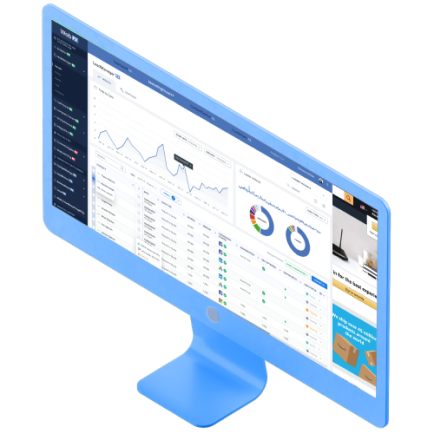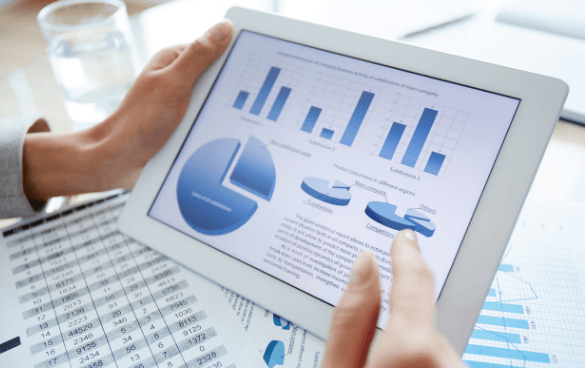-
 9 min. read
9 min. read
-
 Sarah Berry
Sarah Berry Web Marketing Consultant
Web Marketing Consultant
- Sarah Berry is a Google Analytics-certified Web Marketing Consultant at WebFX. She’s written over 400 articles on digital marketing, covering topics like SEO, CRO, and Amazon. When she isn’t polishing her Time Magazine Person of the Year Award, she’s spending time with her flock of ducks.
Branding and bottom-of-the-funnel (BOFU) marketing are both vital to your business’s success. Top-of-the-funnel (TOFU) branding efforts increase brand awareness and get people interested in your company, while BOFU marketing drives sales — providing your business with the fuel it needs to grow. It’s important for branding and BOFU marketing to work in tandem, although it’s easy for these two aspects of a business to become disconnected.
Part of the reason for this disconnection is that it’s much more challenging to measure the impact of branding campaigns than bottom-of-the-funnel marketing. How can you better monitor your branding’s impact, ensure your branding and BOFU efforts work well together and get more from your branding? By combining aspects of performance-based marketing with traditional branding to form an approach called performance branding.
What is performance branding?
Performance branding is a cross-departmental strategy that blends driving conversions with building brand awareness. Performance branding targets multiple stages of the funnel to achieve macro- and micro-conversions.
Performance branding: Explained
Performance branding is an approach to establishing and promoting your company’s unique identity that incorporates aspects of performance-based marketing. Performance branding encourages the use of quantitative data and measurable key performance indicators (KPIs).
It also advocates taking a more cohesive approach to promoting your business instead of branding and bottom-of-the-funnel marketing operating separately.
Performance-based branding involves thinking about the entire customer journey and making sure your branding and other marketing efforts align.
Traditional branding vs. performance-based marketing
To help get a better understanding of performance branding, let’s compare traditional branding and performance-based marketing.
Traditional branding
Branding efforts are those that help a business establish and increase awareness of its unique identity. Branding initiatives are top-of-the-funnel activities. People who are just discovering a brand aren’t likely ready to purchase from it, and it’ll be a while before they make it to the bottom of the funnel — where they make a purchase and become a customer.
Branding also focuses on qualitative assessments, like brand awareness and sentiment. Because branding relies on qualitative assessments, it’s harder to measure the outcomes of branding campaigns. Companies also typically target broader audiences with their branding, although this is changing somewhat.
Rather than targeting specific leads, companies aim to make as many people as possible aware of their brand, for instance. This broader targeting sometimes leads to businesses using more traditional outbound advertising channels, such as billboards and TV ads. These channels reach a wide audience and don’t require precise targeting.
Performance-based marketing
Bottom-of-the-funnel marketing tends to be more performance-based than traditional branding.
This type of marketing focuses on specific metrics like leads or sales generated. It also targets users who are much closer to making a purchase, making it easier to link marketing campaigns to completing goals like increasing sales revenue. Because of these attributes, businesses tend to track their bottom-of-the-funnel marketing much more closely than their branding efforts.
The transition to performance-based branding
Numerous factors contribute to the increase in interest in performance branding. One crucial factor is expanded access to marketing analytics. Over the years, marketing analytics tools have simultaneously become more advanced and more accessible.
Anyone can now collect marketing data, analyze it, and interpret it using marketing analytics tools like Google Analytics, Power BI, and MarketingCloudFX. Many analytics tools use artificial intelligence and various other technologies while providing easy-to-understand data visualizations. These tools can also pull data from numerous channels and campaigns so you can analyze it all in one place and get a more comprehensive view of how your branding and marketing work together.
Along with this, marketing continues to move away from traditional channels toward digital ones. Spending on digital advertising surpassed traditional for the first time in 2019, and digital continues to grow in popularity. With digital marketing, it’s much easier to track the results of your campaigns, and you can gather precise data about your leads, customers, and conversions thanks to digital technologies.
These tracking methods also link seamlessly with marketing analytics tools. With traditional marketing, you don’t have these advanced capabilities, so the rise of digital marketing has helped fuel the move toward performance-based marketing and performance branding. Are you interested in custom reporting that is specific to your unique business needs? Powered by MarketingCloudFX, WebFX creates custom reports based on the metrics that matter most to your company.Measuring the metrics that affect your bottom line.
Learn More 

Benefits of performance branding
The benefits of performance branding also contribute to its growing popularity.
Some of the advantages performance-based branding can provide include the following.
Improved campaign insights
The use of analytics gives you access to improved insights into how your branding efforts are working. This data helps you to make more informed decisions and continuously improve your campaigns. For example, you can figure out which advertising channels get the best results.
You can then focus more of your budget on the most effective channels or update your strategies to improve your results.
A more integrated approach
Performance branding can also give you a more cohesive view of your marketing and branding. This helps you ensure that all aspects of your campaigns work together and can help you improve the results on both ends. For example, you can ensure your branding targets people who are likely to become customers and make sure that your marketing efforts are consistent with your brand.
How to get started with performance branding
Does performance branding sound like something you want to start using?
Here’s how to get started.
1. Set goals
A crucial first step is setting goals for your branding. You need to know what you hope to accomplish, so you know what metrics you need to monitor and improve. The best brand goals are SMART goals, which are:
- Specific: Make your goals detailed and avoid ambiguity.
- Measurable: Your goals should be quantifiable, and there should be a way to gauge your progress.
- Achievable: While your goals can be ambitious, they should also be realistically achievable.
- Relevant: Your branding goals should be relevant to your overall business goals.
- Time-bound: Put a time limit on achieving your goals to help keep you on track.
Some examples of goals you might set include:
- Increase search volume for branded keywords by 25% in the next six months
- Increase brand recall by 30% by the end of the year
- Increase social media engagement by 15% by the end of the quarter
We’ll discuss the metrics and tools you can use to track these kinds of goals in the following sections.
2. Choose metrics to track
Next, choose what metrics you’ll track to measure your progress toward your goals. As we mentioned, tracking branding performance can be challenging, but there are metrics you can use. Take some time to experiment and find the best metrics for your company.
There are no one-size-fits-all solutions, but here are a few ideas.
- Brand recall: The number of people who remember or recognize your brand is useful for measuring brand awareness.
- Website traffic: The amount of traffic coming to your website can help you estimate the reach and popularity of your brand. Also, pay attention to where your traffic is coming
- Search volume for branded keywords: How many people are looking for your business on Google and other search engines? Search volume indicates how many people are actively seeking out your business online.
- Backlinks: If your website is organically earning more links, this is a good sign that your reach is expanding online.
- Social followers: Social media is a valuable tool for measuring branding success. The number of followers your brand has is an excellent measure of its popularity.
- Social mentions: You can also track the number of times people mention your brand on social media, whether on your profiles or elsewhere.
- Social reach: Social reach is a measure of how many people see your name on social media. To measure this, consider the number of mentions and how many people will likely see those mentions.
- Social engagement: Engagement through comments, posts, and other interaction types is a great way to monitor the number of users who are more actively interested in your brand.
3. Choose tools
Another crucial step is choosing the tools you’ll use to measure your branding metrics. Some useful tools include:
- Surveys: Consider sending out surveys to existing customers or surveying a sample of random people. You can conduct surveys via email, phone, and social media, on your website, and in person. Try asking existing customers how they heard of you and asking random survey takers if they recognize your brand.
- Website analytics tools: Website analytics tools such as Google Analytics are an excellent way to measure website traffic, interactions, and more.
- SEO and keyword research tools: Using SEO tools like Ahrefs and Google Trends, you can research keyword search volume, backlinks, and more.
- Social media analytics tools: Social media analytics tools, including ones built into the platforms and third-party tools, are powerful brand tracking tools.
- Social media monitoring tools: You can also use various social media monitoring tools to track mentions of your brand on social media.
One platform tracking countless metrics and driving stellar results.Meet MarketingCloudFX:


4. Experiment with new branding campaign tactics
Once you have your branding performance tracking tools ready, continue following your branding campaign strategies. As you do so, though, keep track of your results and start experimenting with new tactics. As you make changes to your campaigns, monitor the results and update your strategies accordingly.
If you try a new approach and it works well, consider investing more into that method. If a campaign doesn’t meet your expectations, adjust various elements until you get the results you’re looking for. Also, consider running A/B tests — tests in which you change an element of an ad, page, or other item and see which version performs best.
Then, you implement the winning version as the final one.
5. Continually refine your campaigns
As you gather more data and try more new tactics, continue refining your branding strategy. Also, use the data you collect to ensure your branding and marketing efforts remain aligned. Improving the results of your branding and marketing is a continual process.
You should always track data, run tests, and adjust your campaigns. As you do, your campaigns will get better and better over time. Due to its focus on measurable KPIs and improved visibility into your campaigns, performance branding sets you up for success with this process of continual improvement.
Work with performance branding and digital marketing experts
Want help getting started with performance branding and improving the success of your branding and marketing efforts?
Consider working with WebFX! We offer marketing analytics services and a full suite of digital marketing services, from social media marketing to SEO. We can help you reach your branding and marketing goals — just ask the more than 1,100 happy clients who have provided testimonials about our work!
To learn more, request a free quote online or call us at 888-601-5359.
-
 Sarah Berry is a Google Analytics-certified Web Marketing Consultant at WebFX. She’s written over 400 articles on digital marketing, covering topics like SEO, CRO, and Amazon. When she isn’t polishing her Time Magazine Person of the Year Award, she’s spending time with her flock of ducks.
Sarah Berry is a Google Analytics-certified Web Marketing Consultant at WebFX. She’s written over 400 articles on digital marketing, covering topics like SEO, CRO, and Amazon. When she isn’t polishing her Time Magazine Person of the Year Award, she’s spending time with her flock of ducks. -

WebFX is a full-service marketing agency with 1,100+ client reviews and a 4.9-star rating on Clutch! Find out how our expert team and revenue-accelerating tech can drive results for you! Learn more
Try our free Marketing Calculator
Craft a tailored online marketing strategy! Utilize our free Internet marketing calculator for a custom plan based on your location, reach, timeframe, and budget.
Plan Your Marketing Budget

Maximize Your Marketing ROI
Claim your free eBook packed with proven strategies to boost your marketing efforts.
Get the GuideTry our free Marketing Calculator
Craft a tailored online marketing strategy! Utilize our free Internet marketing calculator for a custom plan based on your location, reach, timeframe, and budget.
Plan Your Marketing Budget





